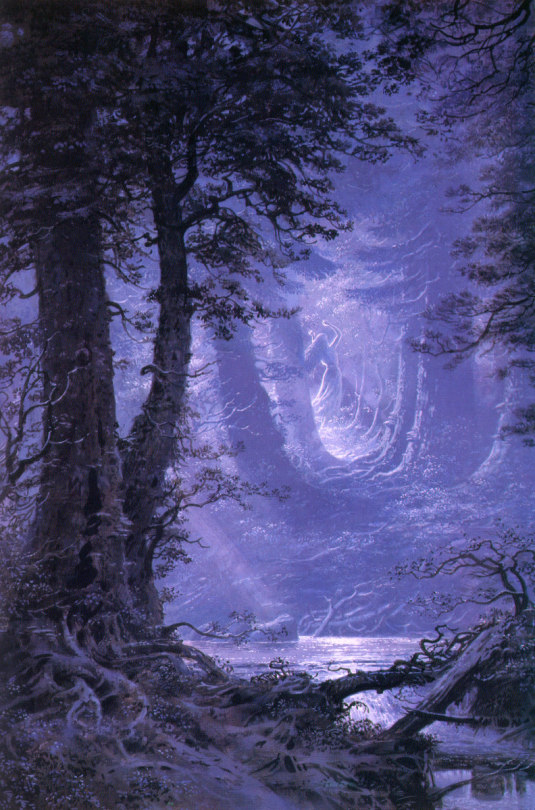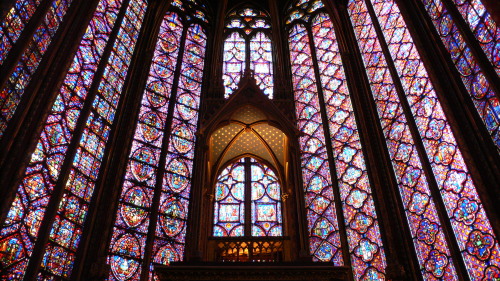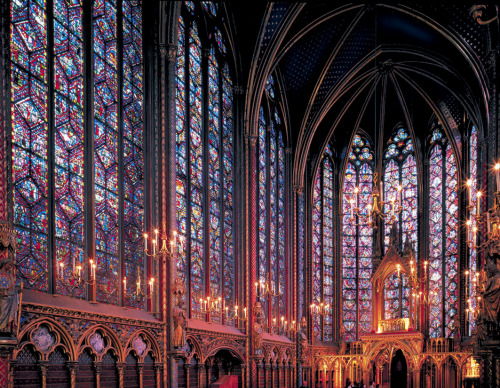By Moonlight In Neldoreth Forest - Ted Nasmith

By Moonlight in Neldoreth Forest - Ted Nasmith
More Posts from Ancientpansy and Others

A View of Naples through a Window, 1824. Franz Ludwig Catel

Abbotsford House







Yesterday I visited the Penates - the house of Russian painter Ilya Repin. It stands surrounded by pine forest, and the Bay of Finland is a 5 minute walk from the house.
The wooden house is very Russian style with little roofs and multiple terraces and enamel fireplaces in every room. There's a large studio on the second floor with large windows and skylights to allow as much natural light in as possible.
Repin was a very prolific painter and a huge name in his day, but also a bit of an eccentric. He always slept in a small unheated terrace, even through the winter. Him and his wife were vegetarian and practiced no-help dinner parties (with no servants at the door or the table). His weekly dinner parties on Wednesdays were attended by a multitude of artists, musicians, scientists. He was friends with Gorky, Mayakovsky, Chukovsky, Tolstoy, Yesenin etc. etc.
(Last picture: Ilya Repin paints opera singer Fyodor Shalyapin in his studio, 1914.)

Coughton Court from the East
Artist: Allen Edward Everitt (English, 1824-1882)
Date: n. d.
Medium: Watercolour
Collection: Birmingham Museum and Art Gallery, Birmingham, United Kingdom

Church of Chavenay
Yveline region of France
Pierre Poschadel









@utopie-sempiternelle

This is the view from Charlotte Brontë’s bedroom (now the Brontë Parsonage Museum), Haworth, Yorkshire. Charlotte was an English novelist and poet, the eldest of the three Brontë sisters whose novels became classics of English literature.







Period drama + Reading
NORTHANGER ABBEY (2007)
COLETTE(2018)
BRIGHT STAR (2009)
MR. MALCOLM'S LIST(2022)
ANNE OF GREEN GABLES (1985)
EMMA. (2020)
BECOMING JANE (2007)



The Stained Glass of Sainte-Chapelle
Interior of the upper chapel (looking northeast), Sainte-Chapelle, Paris, France, 1243–1248
This chapel is a masterpiece of the so-called Rayonnant (radiant) style of the High Gothic age, which dominated the second half of the century. It was the preferred style of the royal Parisian court of Saint Louis. Sainte-Chapelle’s architect carried the dissolution of walls and the reduction of the bulk of the supports to the point that some 6,450 square feet of stained glass make up more than than three-quarters of the structure. The emphasis is on the extreme slenderness of the architectural forms and on linearity in general. Although the chapel required restoration in the 19th century (after suffering damage during the French Revolution), it retains most of its original 13th-century stained glass. Approximately 49 feet high and 15 feet wide, they were the largest designed up to their time. (source)

-
 sarallicious liked this · 2 weeks ago
sarallicious liked this · 2 weeks ago -
 ahscainftflorence liked this · 2 weeks ago
ahscainftflorence liked this · 2 weeks ago -
 kuruizakihime liked this · 2 weeks ago
kuruizakihime liked this · 2 weeks ago -
 spacechilds-mothergoose liked this · 2 weeks ago
spacechilds-mothergoose liked this · 2 weeks ago -
 sporeghost reblogged this · 2 weeks ago
sporeghost reblogged this · 2 weeks ago -
 137152666 liked this · 2 weeks ago
137152666 liked this · 2 weeks ago -
 sharkgutz83 liked this · 2 weeks ago
sharkgutz83 liked this · 2 weeks ago -
 nature-played-a-trick-on-me reblogged this · 2 weeks ago
nature-played-a-trick-on-me reblogged this · 2 weeks ago -
 bl00dydemise liked this · 2 weeks ago
bl00dydemise liked this · 2 weeks ago -
 hewhofightsmonsters liked this · 2 weeks ago
hewhofightsmonsters liked this · 2 weeks ago -
 carnifexofhate liked this · 2 weeks ago
carnifexofhate liked this · 2 weeks ago -
 sewn-on-petals liked this · 2 weeks ago
sewn-on-petals liked this · 2 weeks ago -
 ultramarinelesbo reblogged this · 2 weeks ago
ultramarinelesbo reblogged this · 2 weeks ago -
 ultramarinelesbo liked this · 2 weeks ago
ultramarinelesbo liked this · 2 weeks ago -
 flightoflucifer reblogged this · 2 weeks ago
flightoflucifer reblogged this · 2 weeks ago -
 cold-heart-legacy reblogged this · 2 weeks ago
cold-heart-legacy reblogged this · 2 weeks ago -
 bellona-et-pax reblogged this · 2 weeks ago
bellona-et-pax reblogged this · 2 weeks ago -
 bellona-et-pax liked this · 2 weeks ago
bellona-et-pax liked this · 2 weeks ago -
 tasteofchaoz liked this · 2 weeks ago
tasteofchaoz liked this · 2 weeks ago -
 somafalls reblogged this · 2 weeks ago
somafalls reblogged this · 2 weeks ago -
 lillyfell liked this · 2 weeks ago
lillyfell liked this · 2 weeks ago -
 ancientpansy reblogged this · 2 weeks ago
ancientpansy reblogged this · 2 weeks ago -
 ancientpansy liked this · 2 weeks ago
ancientpansy liked this · 2 weeks ago -
 kingpurpura liked this · 2 weeks ago
kingpurpura liked this · 2 weeks ago -
 kingpurpura reblogged this · 2 weeks ago
kingpurpura reblogged this · 2 weeks ago -
 drwnkinloves reblogged this · 2 weeks ago
drwnkinloves reblogged this · 2 weeks ago -
 dyskomike liked this · 2 weeks ago
dyskomike liked this · 2 weeks ago -
 sai-cere liked this · 2 weeks ago
sai-cere liked this · 2 weeks ago -
 birdiedotjpg reblogged this · 2 weeks ago
birdiedotjpg reblogged this · 2 weeks ago -
 hagoftheundergrowthh liked this · 2 weeks ago
hagoftheundergrowthh liked this · 2 weeks ago -
 sdenkita reblogged this · 2 weeks ago
sdenkita reblogged this · 2 weeks ago -
 sdenkita liked this · 2 weeks ago
sdenkita liked this · 2 weeks ago -
 soloquiero-jugar reblogged this · 2 weeks ago
soloquiero-jugar reblogged this · 2 weeks ago -
 goretones liked this · 2 weeks ago
goretones liked this · 2 weeks ago -
 strangestcase liked this · 2 weeks ago
strangestcase liked this · 2 weeks ago -
 kavinam-indra-bharathi liked this · 2 weeks ago
kavinam-indra-bharathi liked this · 2 weeks ago -
 fallenrazziel reblogged this · 2 weeks ago
fallenrazziel reblogged this · 2 weeks ago -
 fallenrazziel liked this · 2 weeks ago
fallenrazziel liked this · 2 weeks ago -
 9000teeth reblogged this · 2 weeks ago
9000teeth reblogged this · 2 weeks ago -
 bitchymiracletree liked this · 2 weeks ago
bitchymiracletree liked this · 2 weeks ago -
 mymischa liked this · 2 weeks ago
mymischa liked this · 2 weeks ago -
 rockett-to-the-purple-moon liked this · 2 weeks ago
rockett-to-the-purple-moon liked this · 2 weeks ago -
 mr-olbap reblogged this · 2 weeks ago
mr-olbap reblogged this · 2 weeks ago -
 moonyjulie liked this · 2 weeks ago
moonyjulie liked this · 2 weeks ago -
 missmagoo18 reblogged this · 2 weeks ago
missmagoo18 reblogged this · 2 weeks ago -
 hobsgoblins reblogged this · 2 weeks ago
hobsgoblins reblogged this · 2 weeks ago -
 victorianbunnies reblogged this · 2 weeks ago
victorianbunnies reblogged this · 2 weeks ago -
 silvercatwriting reblogged this · 2 weeks ago
silvercatwriting reblogged this · 2 weeks ago -
 silvercatwriting liked this · 2 weeks ago
silvercatwriting liked this · 2 weeks ago -
 quiet-curious reblogged this · 2 weeks ago
quiet-curious reblogged this · 2 weeks ago
Old things are always in good repute, present things in disfavor. Tacitus
3 posts